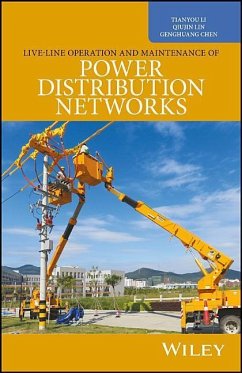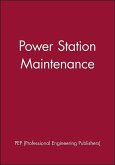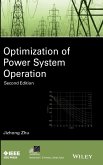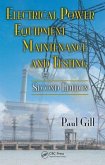Tianyou Li, Qiujin Lin, Genghuang Chen
Live-Line Operation and Maintenance of Power Distribution Networks
Tianyou Li, Qiujin Lin, Genghuang Chen
Live-Line Operation and Maintenance of Power Distribution Networks
- Gebundenes Buch
- Merkliste
- Auf die Merkliste
- Bewerten Bewerten
- Teilen
- Produkt teilen
- Produkterinnerung
- Produkterinnerung
This book examines the methods and techniques of live-line working on distribution networks, which are closely combined with field practices and management experiences. A range of detailed field working illustrations, plus panoramic field graphics, are provided to help readers understand and address practical engineering challenges. * Introduces live-line working technology for the operation and maintenance of medium and low voltage power distribution networks, covering methods and techniques of live-line working on distribution networks with O&M field practices and experiences * Elaborates…mehr
Andere Kunden interessierten sich auch für
![Power Station Maintenance Power Station Maintenance]() Pep (Professional Engineering Publishers)Power Station Maintenance370,99 €
Pep (Professional Engineering Publishers)Power Station Maintenance370,99 €![Basic Live Sound Reinforcement Basic Live Sound Reinforcement]() Raven BiedermanBasic Live Sound Reinforcement197,99 €
Raven BiedermanBasic Live Sound Reinforcement197,99 €![Optimization of Power System Operation Optimization of Power System Operation]() Jizhong ZhuOptimization of Power System Operation165,99 €
Jizhong ZhuOptimization of Power System Operation165,99 €![Electrical Power Equipment Maintenance and Testing Electrical Power Equipment Maintenance and Testing]() Paul GillElectrical Power Equipment Maintenance and Testing319,99 €
Paul GillElectrical Power Equipment Maintenance and Testing319,99 €![Implementation of Live Telecasting Robo Implementation of Live Telecasting Robo]() M.Aravind KumarImplementation of Live Telecasting Robo30,99 €
M.Aravind KumarImplementation of Live Telecasting Robo30,99 €![The Live Event Video Technician The Live Event Video Technician]() Tim KuschelThe Live Event Video Technician198,99 €
Tim KuschelThe Live Event Video Technician198,99 €![Variable Frequency Transformers for Large Scale Power Systems Interconnection Variable Frequency Transformers for Large Scale Power Systems Interconnection]() Gesong ChenVariable Frequency Transformers for Large Scale Power Systems Interconnection159,99 €
Gesong ChenVariable Frequency Transformers for Large Scale Power Systems Interconnection159,99 €-
-
-
This book examines the methods and techniques of live-line working on distribution networks, which are closely combined with field practices and management experiences. A range of detailed field working illustrations, plus panoramic field graphics, are provided to help readers understand and address practical engineering challenges. * Introduces live-line working technology for the operation and maintenance of medium and low voltage power distribution networks, covering methods and techniques of live-line working on distribution networks with O&M field practices and experiences * Elaborates the technical basis and working principles of live-line working in detail, with current application technology, tools and working methods * Combining theory and practice closely, it provides technical guidance and helpful references to technical personnel who are engaged in distribution operation management, as well as related academics and researchers * Written by a team of authors with extensive experience in both industry and academic fields, providing first-hand testimony of the issues facing electricity distribution companies, and offering sound theoretical foundations and rich field experiences This useful reference is written with power engineers in mind; graduate students of electrical engineering and industry professionals will also benefit from this comprehensive text.
Hinweis: Dieser Artikel kann nur an eine deutsche Lieferadresse ausgeliefert werden.
Hinweis: Dieser Artikel kann nur an eine deutsche Lieferadresse ausgeliefert werden.
Produktdetails
- Produktdetails
- Verlag: Wiley
- Seitenzahl: 296
- Erscheinungstermin: 12. Juni 2017
- Englisch
- Abmessung: 218mm x 140mm x 30mm
- Gewicht: 680g
- ISBN-13: 9781119055532
- ISBN-10: 1119055539
- Artikelnr.: 46602023
- Herstellerkennzeichnung
- Libri GmbH
- Europaallee 1
- 36244 Bad Hersfeld
- gpsr@libri.de
- Verlag: Wiley
- Seitenzahl: 296
- Erscheinungstermin: 12. Juni 2017
- Englisch
- Abmessung: 218mm x 140mm x 30mm
- Gewicht: 680g
- ISBN-13: 9781119055532
- ISBN-10: 1119055539
- Artikelnr.: 46602023
- Herstellerkennzeichnung
- Libri GmbH
- Europaallee 1
- 36244 Bad Hersfeld
- gpsr@libri.de
Tianyou Li, State Grid Fujian Electric Power Company Limited, China QIUJIN LIN, Quanzhou Power Bureau, China Genghuang Chen, Quanzhou Power Bureau, China
Foreword xi Preface xiii Introduction 1 1 Overview 3 1.1 Basic Concept of Non
Service Interruption Working 3 1.1.1 Basic Method of Live Line Working 4 1.1.2 Bypass Working and Mobile Power Working 6 1.2 Development of Working Techniques 8 1.2.1 Development History of Live Line Working 8 1.2.2 From Live Line Working to Live Line Working Robot 10 1.2.3 Live Line Working by Helicopter 12 1.2.4 Development From Live Line Working to Non
Service Interruption Working 15 1.3 Power Supply Reliability and Power Outage Losses 15 1.3.1 Reliability Indexes 16 1.3.2 Analysis of Indexes of Power Supply Reliability 17 1.3.3 Power Outage Losses 20 1.4 Analysis of Effect of Working Techniques 23 References 26 2 Distribution Grid and Its Working Techniques 27 2.1 Basic Concept of Distribution Grid 27 2.2 Basic Configuration of Distribution Grid 31 2.2.1 Distribution Network Configuration 31 2.2.2 Composition of Overhead Distribution Lines 34 2.2.3 Composition of Distribution Cable Line 50 2.2.4 Other Common Distribution Equipment 54 2.3 Technical Principles of Distribution Non
Service Interruption Working 63 2.3.1 Earth Potential Working 65 2.3.2 Middle Potential Working 67 2.3.3 Equipotential Working 69 2.4 Types of Distribution Line Poles and Live Line Working 70 2.4.1 Classification of Pole Types 70 2.4.2 Conductor Spacing in Tower and Spacing Between Conductors and Surroundings 72 2.4.3 Types of Poles Suitable for Live Line Working 75 References 77 3 Theoretical Basis of Working Techniques 79 3.1 Analysis of Influence of Electricity on Human Bodies 79 3.1.1 Influence Brought by Current on Human Bodies 79 3.1.2 Influence of Electric Field on Human Bodies 81 3.2 Overvoltage During Working 84 3.2.1 Switching Overvoltage 85 3.2.2 Temporary Overvoltage 86 3.3 Dielectric Properties 89 3.3.1 Conductance and Insulation Resistance of Dielectric 89 3.3.2 Breakdown Strength and Discharge Characteristic of Dielectric 94 3.4 Insulation Coordination and Safety Spacing 101 3.4.1 Insulation Coordination 101 3.4.2 Safety Spacing 107 References 110 4 Common Working Tools and Usages 111 4.1 Insulating Tools 111 4.1.1 Common Insulating Materials 111 4.1.2 Insulating Poles 114 4.1.3 Insulating Ropes and Cords 118 4.2 Protective Appliances 122 4.2.1 Insulating Shielding Appliances 123 4.2.2 Insulating Blanket (Mat) 125 4.2.3 Insulating Protective Appliances 126 4.3 Other Working Tools 131 4.3.1 Tensioner 131 4.3.2 Insulating Tape Lever Hoist 132 4.3.3 Instruments and Meters 133 4.4 The Making of Working Tools 139 4.4.1 Material Selection 139 4.4.2 Design and Processing 141 4.4.3 Simulation Drill and Practical Application 144 4.5 The Usage and Management of Working Tools 146 4.5.1 Storage and Maintenance of Live Line Working Tools 146 4.5.2 Warehouse of Live Line Working Tools and Management 147 4.5.3 Modern Identifications and Intelligent Management of Tools 160 References 161 5 Test Techniques for Working Tools 163 5.1 Test Items 163 5.1.1 Classification of Tests 163 5.1.2 Test Items 164 5.1.3 Technical Standards of Tests 166 5.2 Test of Common Insulating Tools 169 5.2.1 Test of Insulating Pole 169 5.2.2 Test of Insulating Tackle 177 5.2.3 Test of Insulating Hard Ladder 178 5.2.4 Test of Insulating Rope 180 5.2.5 Test of Insulating Hand Tool 184 5.2.6 Test of Insulating Shielding Cover 187 5.2.7 Test of Insulating Blanket (Mat) 191 5.2.8 Test of Insulating Clothing (Shawls) 193 5.2.9 Test of Insulating Gloves 195 5.2.10 Test of Insulating Shoes (Boots) 197 5.2.11 Test of Insulating Helmet 198 References 200 6 Application of Aerial Device with Insulating Boom and Insulating Platform 201 6.1 Aerial Device with Insulating Boom 201 6.1.1 Introduction to Aerial Device with Insulating Boom 201 6.1.2 Use and Operation of Aerial Device with Insulating Boom 205 6.1.3 Maintenance and Service of Aerial Device with Insulating Boom 213 6.1.4 Test of Aerial Device with Insulating Boom 215 6.2 Insulating Platform 226 6.2.1 Introduction to Insulating Platform 226 6.2.2 Use and Maintenance of Insulating Platform 228 6.2.3 Test of Insulating Platform 229 6.3 Operational Robot 236 6.3.1 Introduction to Operational Robots 236 6.3.2 Working Tools 248 6.3.3 Test of Insulation Performance 251 References 255 7 Medium
Voltage Distribution Live Line Working 257 7.1 Basic Working Procedures and Methods 257 7.1.1 Meteorological Conditions for Working 257 7.1.2 Basic Working Procedures 260 7.1.3 Working Instructions 264 7.1.4 Basic Working Methods 265 7.2 Working Techniques for Simple and Regular Works 269 7.2.1 Repairing Conductors 269 7.2.2 Live Line Connection (Removal) of NöLoad By
Pass Jumpers 272 7.2.3 Replacing Tension Insulators 286 7.2.4 Replacing Cross Arms and Insulators in a Suspension Pole 290 7.2.5 Replacing Lightening Arresters 293 7.3 Working Techniques for Complex and Comprehensive Works 296 7.3.1 Live Line Installation of a Pole 296 7.3.2 Replacing a Suspension Pole 310 7.3.3 Changing a Suspension Pole to a Tension Pole 316 7.3.4 On
Load Replacement of Pole
Mounted Switches 322 7.3.5 On
Load Installation of Pole
Mounted Breakers 332 References 337 8 Low
Voltage Distribution Live Line Working 339 8.1 Key Working Techniques 339 8.1.1 Safety Measures for Working 339 8.1.2 Technical Measures for Working 342 8.2 Working Items and Methods 343 8.2.1 Live Line Connection of a Low
Voltage Service Conductor 343 8.2.2 Connection of Power Source for a Low
Voltage Distribution Box 345 8.2.3 Live Line Treatment of a Broken Service Conductor 347 8.2.4 Live Line Replacement of a Three
Phase Four
Wire Watt
Hour Meter 348 8.2.5 Live Line Isolation of a Failed Watt
Hour Meter 350 References 351 9 Bypass Working and Mobile Power Working 353 9.1 Basic Methods of Bypass Working 353 9.1.1 Bypass Cable Method 354 9.1.2 Bypass Overhead Line Method 359 9.1.3 Safety Measures for Bypass Working 363 9.2 Mobile Generation Working Techniques 364 9.2.1 Operating Principle and Wiring 365 9.2.2 Operations of Mobile Generator Vehicle 366 9.2.3 Method of Power Supply by Mobile Generator Vehicle 371 9.3 EPS Working Techniques 374 9.3.1 Operating Principle of EPS 374 9.3.2 Operations of EPS Vehicle 378 9.3.3 Operating Essentials of Power Supply by EPS Vehicle 379 9.3.4 Maintenance of EPS Vehicle 381 9.4 Mobile Prefabricated Transformer Working Techniques 384 9.4.1 Power Supply Principle of Mobile Prefabricated Transformer 384 9.4.2 Changing Pole
Mounted Transformer 386 9.5 Cable Non
Service Interruption Working Techniques 391 9.5.1 Overview of Power Supply Using Bypass Cable 391 9.5.2 Equipment Commonly Used for Working 393 9.5.3 Main Working Techniques 403 References 432 10 Working Management and Emergency Measures 433 10.1 Work Management 433 10.1.1 Organization and Management 433 10.1.2 Safety Management 435 10.1.3 Relevant Regulations and Technical Standards 437 10.1.4 Working Management Documents 438 10.1.5 Management of New Working Subjects 439 10.1.6 Management of New R&D Projects 441 10.2 Training and Management of Workers 441 10.2.1 Induction Training of New Workers 442 10.2.2 Daily Training of Workers 442 10.2.3 Assessment and Management of Workers 443 10.2.4 Training Base 443 10.3 Emergency Measures for Working 444 10.3.1 Emergency Measures for Abrupt Change of Weather 445 10.3.2 Emergency Measures for Failure of Major Working Tools 446 10.3.3 Emergency Measures for Personal Injuries 448 10.3.4 Training and Drill 453 References 453 Annex: Distribution Non
service Interruption Working Instructions (Template) 455 Appendix 1: General Guidelines for Safety of Live Line Working 467 Appendix 2: Technical Guidelines for Common Working Tools 477 Index 501
Service Interruption Working 3 1.1.1 Basic Method of Live Line Working 4 1.1.2 Bypass Working and Mobile Power Working 6 1.2 Development of Working Techniques 8 1.2.1 Development History of Live Line Working 8 1.2.2 From Live Line Working to Live Line Working Robot 10 1.2.3 Live Line Working by Helicopter 12 1.2.4 Development From Live Line Working to Non
Service Interruption Working 15 1.3 Power Supply Reliability and Power Outage Losses 15 1.3.1 Reliability Indexes 16 1.3.2 Analysis of Indexes of Power Supply Reliability 17 1.3.3 Power Outage Losses 20 1.4 Analysis of Effect of Working Techniques 23 References 26 2 Distribution Grid and Its Working Techniques 27 2.1 Basic Concept of Distribution Grid 27 2.2 Basic Configuration of Distribution Grid 31 2.2.1 Distribution Network Configuration 31 2.2.2 Composition of Overhead Distribution Lines 34 2.2.3 Composition of Distribution Cable Line 50 2.2.4 Other Common Distribution Equipment 54 2.3 Technical Principles of Distribution Non
Service Interruption Working 63 2.3.1 Earth Potential Working 65 2.3.2 Middle Potential Working 67 2.3.3 Equipotential Working 69 2.4 Types of Distribution Line Poles and Live Line Working 70 2.4.1 Classification of Pole Types 70 2.4.2 Conductor Spacing in Tower and Spacing Between Conductors and Surroundings 72 2.4.3 Types of Poles Suitable for Live Line Working 75 References 77 3 Theoretical Basis of Working Techniques 79 3.1 Analysis of Influence of Electricity on Human Bodies 79 3.1.1 Influence Brought by Current on Human Bodies 79 3.1.2 Influence of Electric Field on Human Bodies 81 3.2 Overvoltage During Working 84 3.2.1 Switching Overvoltage 85 3.2.2 Temporary Overvoltage 86 3.3 Dielectric Properties 89 3.3.1 Conductance and Insulation Resistance of Dielectric 89 3.3.2 Breakdown Strength and Discharge Characteristic of Dielectric 94 3.4 Insulation Coordination and Safety Spacing 101 3.4.1 Insulation Coordination 101 3.4.2 Safety Spacing 107 References 110 4 Common Working Tools and Usages 111 4.1 Insulating Tools 111 4.1.1 Common Insulating Materials 111 4.1.2 Insulating Poles 114 4.1.3 Insulating Ropes and Cords 118 4.2 Protective Appliances 122 4.2.1 Insulating Shielding Appliances 123 4.2.2 Insulating Blanket (Mat) 125 4.2.3 Insulating Protective Appliances 126 4.3 Other Working Tools 131 4.3.1 Tensioner 131 4.3.2 Insulating Tape Lever Hoist 132 4.3.3 Instruments and Meters 133 4.4 The Making of Working Tools 139 4.4.1 Material Selection 139 4.4.2 Design and Processing 141 4.4.3 Simulation Drill and Practical Application 144 4.5 The Usage and Management of Working Tools 146 4.5.1 Storage and Maintenance of Live Line Working Tools 146 4.5.2 Warehouse of Live Line Working Tools and Management 147 4.5.3 Modern Identifications and Intelligent Management of Tools 160 References 161 5 Test Techniques for Working Tools 163 5.1 Test Items 163 5.1.1 Classification of Tests 163 5.1.2 Test Items 164 5.1.3 Technical Standards of Tests 166 5.2 Test of Common Insulating Tools 169 5.2.1 Test of Insulating Pole 169 5.2.2 Test of Insulating Tackle 177 5.2.3 Test of Insulating Hard Ladder 178 5.2.4 Test of Insulating Rope 180 5.2.5 Test of Insulating Hand Tool 184 5.2.6 Test of Insulating Shielding Cover 187 5.2.7 Test of Insulating Blanket (Mat) 191 5.2.8 Test of Insulating Clothing (Shawls) 193 5.2.9 Test of Insulating Gloves 195 5.2.10 Test of Insulating Shoes (Boots) 197 5.2.11 Test of Insulating Helmet 198 References 200 6 Application of Aerial Device with Insulating Boom and Insulating Platform 201 6.1 Aerial Device with Insulating Boom 201 6.1.1 Introduction to Aerial Device with Insulating Boom 201 6.1.2 Use and Operation of Aerial Device with Insulating Boom 205 6.1.3 Maintenance and Service of Aerial Device with Insulating Boom 213 6.1.4 Test of Aerial Device with Insulating Boom 215 6.2 Insulating Platform 226 6.2.1 Introduction to Insulating Platform 226 6.2.2 Use and Maintenance of Insulating Platform 228 6.2.3 Test of Insulating Platform 229 6.3 Operational Robot 236 6.3.1 Introduction to Operational Robots 236 6.3.2 Working Tools 248 6.3.3 Test of Insulation Performance 251 References 255 7 Medium
Voltage Distribution Live Line Working 257 7.1 Basic Working Procedures and Methods 257 7.1.1 Meteorological Conditions for Working 257 7.1.2 Basic Working Procedures 260 7.1.3 Working Instructions 264 7.1.4 Basic Working Methods 265 7.2 Working Techniques for Simple and Regular Works 269 7.2.1 Repairing Conductors 269 7.2.2 Live Line Connection (Removal) of NöLoad By
Pass Jumpers 272 7.2.3 Replacing Tension Insulators 286 7.2.4 Replacing Cross Arms and Insulators in a Suspension Pole 290 7.2.5 Replacing Lightening Arresters 293 7.3 Working Techniques for Complex and Comprehensive Works 296 7.3.1 Live Line Installation of a Pole 296 7.3.2 Replacing a Suspension Pole 310 7.3.3 Changing a Suspension Pole to a Tension Pole 316 7.3.4 On
Load Replacement of Pole
Mounted Switches 322 7.3.5 On
Load Installation of Pole
Mounted Breakers 332 References 337 8 Low
Voltage Distribution Live Line Working 339 8.1 Key Working Techniques 339 8.1.1 Safety Measures for Working 339 8.1.2 Technical Measures for Working 342 8.2 Working Items and Methods 343 8.2.1 Live Line Connection of a Low
Voltage Service Conductor 343 8.2.2 Connection of Power Source for a Low
Voltage Distribution Box 345 8.2.3 Live Line Treatment of a Broken Service Conductor 347 8.2.4 Live Line Replacement of a Three
Phase Four
Wire Watt
Hour Meter 348 8.2.5 Live Line Isolation of a Failed Watt
Hour Meter 350 References 351 9 Bypass Working and Mobile Power Working 353 9.1 Basic Methods of Bypass Working 353 9.1.1 Bypass Cable Method 354 9.1.2 Bypass Overhead Line Method 359 9.1.3 Safety Measures for Bypass Working 363 9.2 Mobile Generation Working Techniques 364 9.2.1 Operating Principle and Wiring 365 9.2.2 Operations of Mobile Generator Vehicle 366 9.2.3 Method of Power Supply by Mobile Generator Vehicle 371 9.3 EPS Working Techniques 374 9.3.1 Operating Principle of EPS 374 9.3.2 Operations of EPS Vehicle 378 9.3.3 Operating Essentials of Power Supply by EPS Vehicle 379 9.3.4 Maintenance of EPS Vehicle 381 9.4 Mobile Prefabricated Transformer Working Techniques 384 9.4.1 Power Supply Principle of Mobile Prefabricated Transformer 384 9.4.2 Changing Pole
Mounted Transformer 386 9.5 Cable Non
Service Interruption Working Techniques 391 9.5.1 Overview of Power Supply Using Bypass Cable 391 9.5.2 Equipment Commonly Used for Working 393 9.5.3 Main Working Techniques 403 References 432 10 Working Management and Emergency Measures 433 10.1 Work Management 433 10.1.1 Organization and Management 433 10.1.2 Safety Management 435 10.1.3 Relevant Regulations and Technical Standards 437 10.1.4 Working Management Documents 438 10.1.5 Management of New Working Subjects 439 10.1.6 Management of New R&D Projects 441 10.2 Training and Management of Workers 441 10.2.1 Induction Training of New Workers 442 10.2.2 Daily Training of Workers 442 10.2.3 Assessment and Management of Workers 443 10.2.4 Training Base 443 10.3 Emergency Measures for Working 444 10.3.1 Emergency Measures for Abrupt Change of Weather 445 10.3.2 Emergency Measures for Failure of Major Working Tools 446 10.3.3 Emergency Measures for Personal Injuries 448 10.3.4 Training and Drill 453 References 453 Annex: Distribution Non
service Interruption Working Instructions (Template) 455 Appendix 1: General Guidelines for Safety of Live Line Working 467 Appendix 2: Technical Guidelines for Common Working Tools 477 Index 501
Foreword xi Preface xiii Introduction 1 1 Overview 3 1.1 Basic Concept of Non
Service Interruption Working 3 1.1.1 Basic Method of Live Line Working 4 1.1.2 Bypass Working and Mobile Power Working 6 1.2 Development of Working Techniques 8 1.2.1 Development History of Live Line Working 8 1.2.2 From Live Line Working to Live Line Working Robot 10 1.2.3 Live Line Working by Helicopter 12 1.2.4 Development From Live Line Working to Non
Service Interruption Working 15 1.3 Power Supply Reliability and Power Outage Losses 15 1.3.1 Reliability Indexes 16 1.3.2 Analysis of Indexes of Power Supply Reliability 17 1.3.3 Power Outage Losses 20 1.4 Analysis of Effect of Working Techniques 23 References 26 2 Distribution Grid and Its Working Techniques 27 2.1 Basic Concept of Distribution Grid 27 2.2 Basic Configuration of Distribution Grid 31 2.2.1 Distribution Network Configuration 31 2.2.2 Composition of Overhead Distribution Lines 34 2.2.3 Composition of Distribution Cable Line 50 2.2.4 Other Common Distribution Equipment 54 2.3 Technical Principles of Distribution Non
Service Interruption Working 63 2.3.1 Earth Potential Working 65 2.3.2 Middle Potential Working 67 2.3.3 Equipotential Working 69 2.4 Types of Distribution Line Poles and Live Line Working 70 2.4.1 Classification of Pole Types 70 2.4.2 Conductor Spacing in Tower and Spacing Between Conductors and Surroundings 72 2.4.3 Types of Poles Suitable for Live Line Working 75 References 77 3 Theoretical Basis of Working Techniques 79 3.1 Analysis of Influence of Electricity on Human Bodies 79 3.1.1 Influence Brought by Current on Human Bodies 79 3.1.2 Influence of Electric Field on Human Bodies 81 3.2 Overvoltage During Working 84 3.2.1 Switching Overvoltage 85 3.2.2 Temporary Overvoltage 86 3.3 Dielectric Properties 89 3.3.1 Conductance and Insulation Resistance of Dielectric 89 3.3.2 Breakdown Strength and Discharge Characteristic of Dielectric 94 3.4 Insulation Coordination and Safety Spacing 101 3.4.1 Insulation Coordination 101 3.4.2 Safety Spacing 107 References 110 4 Common Working Tools and Usages 111 4.1 Insulating Tools 111 4.1.1 Common Insulating Materials 111 4.1.2 Insulating Poles 114 4.1.3 Insulating Ropes and Cords 118 4.2 Protective Appliances 122 4.2.1 Insulating Shielding Appliances 123 4.2.2 Insulating Blanket (Mat) 125 4.2.3 Insulating Protective Appliances 126 4.3 Other Working Tools 131 4.3.1 Tensioner 131 4.3.2 Insulating Tape Lever Hoist 132 4.3.3 Instruments and Meters 133 4.4 The Making of Working Tools 139 4.4.1 Material Selection 139 4.4.2 Design and Processing 141 4.4.3 Simulation Drill and Practical Application 144 4.5 The Usage and Management of Working Tools 146 4.5.1 Storage and Maintenance of Live Line Working Tools 146 4.5.2 Warehouse of Live Line Working Tools and Management 147 4.5.3 Modern Identifications and Intelligent Management of Tools 160 References 161 5 Test Techniques for Working Tools 163 5.1 Test Items 163 5.1.1 Classification of Tests 163 5.1.2 Test Items 164 5.1.3 Technical Standards of Tests 166 5.2 Test of Common Insulating Tools 169 5.2.1 Test of Insulating Pole 169 5.2.2 Test of Insulating Tackle 177 5.2.3 Test of Insulating Hard Ladder 178 5.2.4 Test of Insulating Rope 180 5.2.5 Test of Insulating Hand Tool 184 5.2.6 Test of Insulating Shielding Cover 187 5.2.7 Test of Insulating Blanket (Mat) 191 5.2.8 Test of Insulating Clothing (Shawls) 193 5.2.9 Test of Insulating Gloves 195 5.2.10 Test of Insulating Shoes (Boots) 197 5.2.11 Test of Insulating Helmet 198 References 200 6 Application of Aerial Device with Insulating Boom and Insulating Platform 201 6.1 Aerial Device with Insulating Boom 201 6.1.1 Introduction to Aerial Device with Insulating Boom 201 6.1.2 Use and Operation of Aerial Device with Insulating Boom 205 6.1.3 Maintenance and Service of Aerial Device with Insulating Boom 213 6.1.4 Test of Aerial Device with Insulating Boom 215 6.2 Insulating Platform 226 6.2.1 Introduction to Insulating Platform 226 6.2.2 Use and Maintenance of Insulating Platform 228 6.2.3 Test of Insulating Platform 229 6.3 Operational Robot 236 6.3.1 Introduction to Operational Robots 236 6.3.2 Working Tools 248 6.3.3 Test of Insulation Performance 251 References 255 7 Medium
Voltage Distribution Live Line Working 257 7.1 Basic Working Procedures and Methods 257 7.1.1 Meteorological Conditions for Working 257 7.1.2 Basic Working Procedures 260 7.1.3 Working Instructions 264 7.1.4 Basic Working Methods 265 7.2 Working Techniques for Simple and Regular Works 269 7.2.1 Repairing Conductors 269 7.2.2 Live Line Connection (Removal) of NöLoad By
Pass Jumpers 272 7.2.3 Replacing Tension Insulators 286 7.2.4 Replacing Cross Arms and Insulators in a Suspension Pole 290 7.2.5 Replacing Lightening Arresters 293 7.3 Working Techniques for Complex and Comprehensive Works 296 7.3.1 Live Line Installation of a Pole 296 7.3.2 Replacing a Suspension Pole 310 7.3.3 Changing a Suspension Pole to a Tension Pole 316 7.3.4 On
Load Replacement of Pole
Mounted Switches 322 7.3.5 On
Load Installation of Pole
Mounted Breakers 332 References 337 8 Low
Voltage Distribution Live Line Working 339 8.1 Key Working Techniques 339 8.1.1 Safety Measures for Working 339 8.1.2 Technical Measures for Working 342 8.2 Working Items and Methods 343 8.2.1 Live Line Connection of a Low
Voltage Service Conductor 343 8.2.2 Connection of Power Source for a Low
Voltage Distribution Box 345 8.2.3 Live Line Treatment of a Broken Service Conductor 347 8.2.4 Live Line Replacement of a Three
Phase Four
Wire Watt
Hour Meter 348 8.2.5 Live Line Isolation of a Failed Watt
Hour Meter 350 References 351 9 Bypass Working and Mobile Power Working 353 9.1 Basic Methods of Bypass Working 353 9.1.1 Bypass Cable Method 354 9.1.2 Bypass Overhead Line Method 359 9.1.3 Safety Measures for Bypass Working 363 9.2 Mobile Generation Working Techniques 364 9.2.1 Operating Principle and Wiring 365 9.2.2 Operations of Mobile Generator Vehicle 366 9.2.3 Method of Power Supply by Mobile Generator Vehicle 371 9.3 EPS Working Techniques 374 9.3.1 Operating Principle of EPS 374 9.3.2 Operations of EPS Vehicle 378 9.3.3 Operating Essentials of Power Supply by EPS Vehicle 379 9.3.4 Maintenance of EPS Vehicle 381 9.4 Mobile Prefabricated Transformer Working Techniques 384 9.4.1 Power Supply Principle of Mobile Prefabricated Transformer 384 9.4.2 Changing Pole
Mounted Transformer 386 9.5 Cable Non
Service Interruption Working Techniques 391 9.5.1 Overview of Power Supply Using Bypass Cable 391 9.5.2 Equipment Commonly Used for Working 393 9.5.3 Main Working Techniques 403 References 432 10 Working Management and Emergency Measures 433 10.1 Work Management 433 10.1.1 Organization and Management 433 10.1.2 Safety Management 435 10.1.3 Relevant Regulations and Technical Standards 437 10.1.4 Working Management Documents 438 10.1.5 Management of New Working Subjects 439 10.1.6 Management of New R&D Projects 441 10.2 Training and Management of Workers 441 10.2.1 Induction Training of New Workers 442 10.2.2 Daily Training of Workers 442 10.2.3 Assessment and Management of Workers 443 10.2.4 Training Base 443 10.3 Emergency Measures for Working 444 10.3.1 Emergency Measures for Abrupt Change of Weather 445 10.3.2 Emergency Measures for Failure of Major Working Tools 446 10.3.3 Emergency Measures for Personal Injuries 448 10.3.4 Training and Drill 453 References 453 Annex: Distribution Non
service Interruption Working Instructions (Template) 455 Appendix 1: General Guidelines for Safety of Live Line Working 467 Appendix 2: Technical Guidelines for Common Working Tools 477 Index 501
Service Interruption Working 3 1.1.1 Basic Method of Live Line Working 4 1.1.2 Bypass Working and Mobile Power Working 6 1.2 Development of Working Techniques 8 1.2.1 Development History of Live Line Working 8 1.2.2 From Live Line Working to Live Line Working Robot 10 1.2.3 Live Line Working by Helicopter 12 1.2.4 Development From Live Line Working to Non
Service Interruption Working 15 1.3 Power Supply Reliability and Power Outage Losses 15 1.3.1 Reliability Indexes 16 1.3.2 Analysis of Indexes of Power Supply Reliability 17 1.3.3 Power Outage Losses 20 1.4 Analysis of Effect of Working Techniques 23 References 26 2 Distribution Grid and Its Working Techniques 27 2.1 Basic Concept of Distribution Grid 27 2.2 Basic Configuration of Distribution Grid 31 2.2.1 Distribution Network Configuration 31 2.2.2 Composition of Overhead Distribution Lines 34 2.2.3 Composition of Distribution Cable Line 50 2.2.4 Other Common Distribution Equipment 54 2.3 Technical Principles of Distribution Non
Service Interruption Working 63 2.3.1 Earth Potential Working 65 2.3.2 Middle Potential Working 67 2.3.3 Equipotential Working 69 2.4 Types of Distribution Line Poles and Live Line Working 70 2.4.1 Classification of Pole Types 70 2.4.2 Conductor Spacing in Tower and Spacing Between Conductors and Surroundings 72 2.4.3 Types of Poles Suitable for Live Line Working 75 References 77 3 Theoretical Basis of Working Techniques 79 3.1 Analysis of Influence of Electricity on Human Bodies 79 3.1.1 Influence Brought by Current on Human Bodies 79 3.1.2 Influence of Electric Field on Human Bodies 81 3.2 Overvoltage During Working 84 3.2.1 Switching Overvoltage 85 3.2.2 Temporary Overvoltage 86 3.3 Dielectric Properties 89 3.3.1 Conductance and Insulation Resistance of Dielectric 89 3.3.2 Breakdown Strength and Discharge Characteristic of Dielectric 94 3.4 Insulation Coordination and Safety Spacing 101 3.4.1 Insulation Coordination 101 3.4.2 Safety Spacing 107 References 110 4 Common Working Tools and Usages 111 4.1 Insulating Tools 111 4.1.1 Common Insulating Materials 111 4.1.2 Insulating Poles 114 4.1.3 Insulating Ropes and Cords 118 4.2 Protective Appliances 122 4.2.1 Insulating Shielding Appliances 123 4.2.2 Insulating Blanket (Mat) 125 4.2.3 Insulating Protective Appliances 126 4.3 Other Working Tools 131 4.3.1 Tensioner 131 4.3.2 Insulating Tape Lever Hoist 132 4.3.3 Instruments and Meters 133 4.4 The Making of Working Tools 139 4.4.1 Material Selection 139 4.4.2 Design and Processing 141 4.4.3 Simulation Drill and Practical Application 144 4.5 The Usage and Management of Working Tools 146 4.5.1 Storage and Maintenance of Live Line Working Tools 146 4.5.2 Warehouse of Live Line Working Tools and Management 147 4.5.3 Modern Identifications and Intelligent Management of Tools 160 References 161 5 Test Techniques for Working Tools 163 5.1 Test Items 163 5.1.1 Classification of Tests 163 5.1.2 Test Items 164 5.1.3 Technical Standards of Tests 166 5.2 Test of Common Insulating Tools 169 5.2.1 Test of Insulating Pole 169 5.2.2 Test of Insulating Tackle 177 5.2.3 Test of Insulating Hard Ladder 178 5.2.4 Test of Insulating Rope 180 5.2.5 Test of Insulating Hand Tool 184 5.2.6 Test of Insulating Shielding Cover 187 5.2.7 Test of Insulating Blanket (Mat) 191 5.2.8 Test of Insulating Clothing (Shawls) 193 5.2.9 Test of Insulating Gloves 195 5.2.10 Test of Insulating Shoes (Boots) 197 5.2.11 Test of Insulating Helmet 198 References 200 6 Application of Aerial Device with Insulating Boom and Insulating Platform 201 6.1 Aerial Device with Insulating Boom 201 6.1.1 Introduction to Aerial Device with Insulating Boom 201 6.1.2 Use and Operation of Aerial Device with Insulating Boom 205 6.1.3 Maintenance and Service of Aerial Device with Insulating Boom 213 6.1.4 Test of Aerial Device with Insulating Boom 215 6.2 Insulating Platform 226 6.2.1 Introduction to Insulating Platform 226 6.2.2 Use and Maintenance of Insulating Platform 228 6.2.3 Test of Insulating Platform 229 6.3 Operational Robot 236 6.3.1 Introduction to Operational Robots 236 6.3.2 Working Tools 248 6.3.3 Test of Insulation Performance 251 References 255 7 Medium
Voltage Distribution Live Line Working 257 7.1 Basic Working Procedures and Methods 257 7.1.1 Meteorological Conditions for Working 257 7.1.2 Basic Working Procedures 260 7.1.3 Working Instructions 264 7.1.4 Basic Working Methods 265 7.2 Working Techniques for Simple and Regular Works 269 7.2.1 Repairing Conductors 269 7.2.2 Live Line Connection (Removal) of NöLoad By
Pass Jumpers 272 7.2.3 Replacing Tension Insulators 286 7.2.4 Replacing Cross Arms and Insulators in a Suspension Pole 290 7.2.5 Replacing Lightening Arresters 293 7.3 Working Techniques for Complex and Comprehensive Works 296 7.3.1 Live Line Installation of a Pole 296 7.3.2 Replacing a Suspension Pole 310 7.3.3 Changing a Suspension Pole to a Tension Pole 316 7.3.4 On
Load Replacement of Pole
Mounted Switches 322 7.3.5 On
Load Installation of Pole
Mounted Breakers 332 References 337 8 Low
Voltage Distribution Live Line Working 339 8.1 Key Working Techniques 339 8.1.1 Safety Measures for Working 339 8.1.2 Technical Measures for Working 342 8.2 Working Items and Methods 343 8.2.1 Live Line Connection of a Low
Voltage Service Conductor 343 8.2.2 Connection of Power Source for a Low
Voltage Distribution Box 345 8.2.3 Live Line Treatment of a Broken Service Conductor 347 8.2.4 Live Line Replacement of a Three
Phase Four
Wire Watt
Hour Meter 348 8.2.5 Live Line Isolation of a Failed Watt
Hour Meter 350 References 351 9 Bypass Working and Mobile Power Working 353 9.1 Basic Methods of Bypass Working 353 9.1.1 Bypass Cable Method 354 9.1.2 Bypass Overhead Line Method 359 9.1.3 Safety Measures for Bypass Working 363 9.2 Mobile Generation Working Techniques 364 9.2.1 Operating Principle and Wiring 365 9.2.2 Operations of Mobile Generator Vehicle 366 9.2.3 Method of Power Supply by Mobile Generator Vehicle 371 9.3 EPS Working Techniques 374 9.3.1 Operating Principle of EPS 374 9.3.2 Operations of EPS Vehicle 378 9.3.3 Operating Essentials of Power Supply by EPS Vehicle 379 9.3.4 Maintenance of EPS Vehicle 381 9.4 Mobile Prefabricated Transformer Working Techniques 384 9.4.1 Power Supply Principle of Mobile Prefabricated Transformer 384 9.4.2 Changing Pole
Mounted Transformer 386 9.5 Cable Non
Service Interruption Working Techniques 391 9.5.1 Overview of Power Supply Using Bypass Cable 391 9.5.2 Equipment Commonly Used for Working 393 9.5.3 Main Working Techniques 403 References 432 10 Working Management and Emergency Measures 433 10.1 Work Management 433 10.1.1 Organization and Management 433 10.1.2 Safety Management 435 10.1.3 Relevant Regulations and Technical Standards 437 10.1.4 Working Management Documents 438 10.1.5 Management of New Working Subjects 439 10.1.6 Management of New R&D Projects 441 10.2 Training and Management of Workers 441 10.2.1 Induction Training of New Workers 442 10.2.2 Daily Training of Workers 442 10.2.3 Assessment and Management of Workers 443 10.2.4 Training Base 443 10.3 Emergency Measures for Working 444 10.3.1 Emergency Measures for Abrupt Change of Weather 445 10.3.2 Emergency Measures for Failure of Major Working Tools 446 10.3.3 Emergency Measures for Personal Injuries 448 10.3.4 Training and Drill 453 References 453 Annex: Distribution Non
service Interruption Working Instructions (Template) 455 Appendix 1: General Guidelines for Safety of Live Line Working 467 Appendix 2: Technical Guidelines for Common Working Tools 477 Index 501








